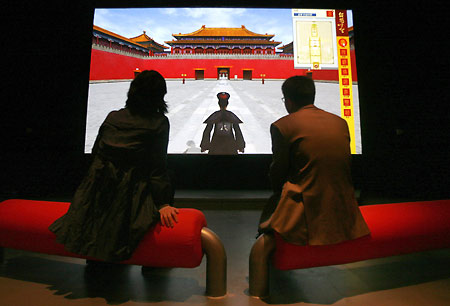IBM on Friday opened online doors to a virtual version of the famed Forbidden City in China that served for centuries as an exclusive realm for the nation's emperors.
The US technology colossus spent more than three years working with Chinese officials and the Palace Museum to construct an interactive, animated replica of the 178-acre (720,000 square-meter) walled fortress in the Dongcheng District of Beijing.

|
|
Visitors to the Forbidden City watch a screen displaying a three dimensional virtual tour of the palace in Beijing October 10, 2008. IBM on Friday opened online doors to a virtual version of the famed Forbidden City in China that served for centuries as an exclusive realm for the nation's emperors. [Agencies]
|
"Forbidden City: Beyond Space & Time," online at www.beyondspaceandtime.org, is billed as a first-of-a-kind, fully immersive, three-dimensional virtual recreation of "this Chinese cultural treasure."
"The rich cultural heritage of China's imperial past, embodied in the Forbidden City for over five centuries, is now brought to life and accessible to all through a virtual world," said Henry Chow, chairman of IBM's Greater China Group.
"This initiative takes the online experience to a new level of innovation with rich content, educational storytelling, community and social networking features that represent the next generation of 3D Internet applications."
Built in the early 14th Century, The Forbidden City served as home to the emperor and the political heart of Chinese government from mid-Ming Dynasty to the end of the Qing Dynasty.
The Forbidden City is now overseen by the Palace Museum and Friday marked the 83rd anniversary of it being open to the public as a cultural attraction.
Visitors to the virtual Forbidden City can explore it as animated characters, or "avatars," able to chat with others or take part in activities such as archery, cricket fighting, or a board game called Weiqi.
Animated tourists can also scrutinize artifacts and scenes including "The Emperor Having Dinner." Virtual tours can be narrowed to topics such as dragons, halls, symbolic animals, or the expansive Imperial Garden.
"The Forbidden City: Beyond Space & Time is a program that combines China's world-class cultural heritage with state-of-the-art information technology," said Palace Museum director-general Zheng Xinmiao.
"This program is only a start, which, as we believe, will have an unlimited future to explore China's traditional culture."
Computer kiosks in the real Forbidden City allow people there to visit the virtual version as well.
(Chinadaily.com.cn via agencies October 13, 2008)